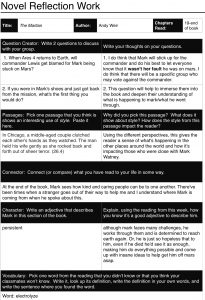
Hello, welcome to my blog! Today I’ll be sharing with you a long lost tale about a Frankenstuffie. This little guy was a creation part of the “Who’s in Control: People or the Environment?” unit we’ve done in PLP. We’ve worked on this unit for a huge chunk of the year and we’ve been very busy bees. To start it off, we read Andy Weir’s ‘The Martian’ and filled out sheets that asked questions like, “Who is in control in this section of the novel: the humans or the environment? Justify your answer with at least two examples from the book.” We would read a handful of chapters every week and fill out these sheets as a reflection to the section we read. Here’s an example of one of the sheets we filled out.
This reflects on the very last few chapters in the book (Warning: SPOILERS AHEAD!) where Mark makes his way to return to his team on the Ares 2 mission. He gets there safely and everyone is happy. But as you can see on the sheets, there are still a few unanswered questions that are driving me crazy. This book had an interesting style because it would include different perspectives from different characters/groups of people. We were introduced to that style of writing so that incase we wanted to include something like it in our epistolary story, we’d have the option.
To give you a better understanding of the epistolary stories, it was basically entries we wrote about the whole story arc of our creature and its adaptation to this new change to its physiographic region. Meaning, the environment changed and so the animal had to change in order to adapt to it. We were first given a place with a certain climate around Canada and my group was assigned the Prairies. I chose to do the SouthEast Prairies and brainstormed what I could put into my story. Here’s a picture of the storyboard I came up with:
After making the storyboard for the epistolary story, it was time to get writing! We did drafts of our epistolary stories and after finishing them had our peers critique them, giving us feedback.
For my epistolary story, I wrote it in a way that Morris the Moose would be writing letters to a friend who’d gone traveling. I went for an older style of writing and was inspired by the language and expressions included in the letters sent in the time period during WW2. I got my inspiration from the letters on this website and found it to be quite easy to adapt to that writing style. Here’s my final epistolary story:








 If you read my epistolary story that i’m so proud of, you’ll notice the antagonist. This was a monster we made as a part of a math project and it was really fun to put together.
If you read my epistolary story that i’m so proud of, you’ll notice the antagonist. This was a monster we made as a part of a math project and it was really fun to put together.
The final part of this project was the video. Our videos were based off of our epistolary story but we were allowed to change a few things. Here’s a picture of the storyboard for my video:
In the end, I didn’t include the antagonist because I just thought it would be a simpler and easier to comprehend if there weren’t any complications with the characters. In its place, I took the environment struggles to a new level and they went on for a long time. Here’s my video:
https://youtu.be/1FRejfJZvdg









